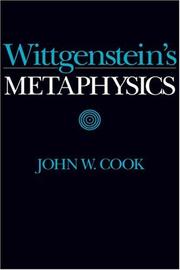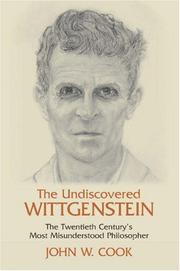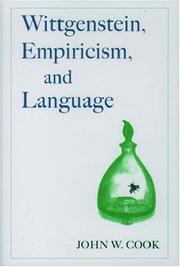| Listing 1 - 10 of 26 | << page >> |
Sort by
|
Image
Abstract | Keywords | Export | Availability | Bookmark
 Loading...
Loading...Choose an application
- Reference Manager
- EndNote
- RefWorks (Direct export to RefWorks)

ISBN: 0521460190 0521062969 0511895364 9780511895364 9780521460194 9780521062961 Year: 1994 Publisher: Cambridge Cambridge University Press
Abstract | Keywords | Export | Availability | Bookmark
 Loading...
Loading...Choose an application
- Reference Manager
- EndNote
- RefWorks (Direct export to RefWorks)
Wittgenstein's Metaphysics offers an interpretation of the fundamental ideas of Ludwig Wittgenstein. It takes issue with the conventional view that after 1930 Wittgenstein rejected the philosophy of the Tractatus and developed a wholly new conception of philosophy. By tracing the evolution of Wittgenstein's ideas Cook shows that they are neither as original nor as difficult as is often supposed. Wittgenstein was essentially an empiricist, and the difference between his early views (as set forth in the Tractatus) and the later views (as expounded in the Philosophical Investigations) lies chiefly in the fact that after 1930 he replaced his version of reductionism with something subtler. Nevertheless, he ended where he began, as an empiricist armed with a theory of meaning.
Metaphysics --- Wittgenstein, Ludwig J.J. --- Metafysica --- Métaphysique --- Reductionism --- Philosophy --- God --- Ontology --- Philosophy of mind --- Wittgenstein, Ludwig --- Wittgenstein, Ludwig, - 1889-1951. --- Wittgenstein, Ludwig, --- Wei-tʻe-ken-ssu-tʻan, --- Wei-tʻe-ken-ssu-tʻan, Lu-te-wei-hsi, --- Wittgenstein, L. --- Vitgenshteĭn, L., --- Wei-ken-ssu-tʻan, --- Pitʻŭgensyutʻain, --- Vitgenshteĭn, Li︠u︡dvig, --- Weitegenshitan, --- Wittgenstein, Ludovicus, --- Vitgenshtaĭn, Ludvig, --- ויטגנשטיין, לודוויג --- 维特根斯坦, --- Wittgenstein, Ludwig Josef Johann, --- Arts and Humanities --- Metaphysics. --- Reductionism.

ISBN: 1591022576 Year: 2005 Publisher: New York (N.Y.) Prometheus
Abstract | Keywords | Export | Availability | Bookmark
 Loading...
Loading...Choose an application
- Reference Manager
- EndNote
- RefWorks (Direct export to RefWorks)
Wittgenstein, Ludwig --- Wittgenstein, Ludwig, --- Wei-tʻe-ken-ssu-tʻan, --- Wei-tʻe-ken-ssu-tʻan, Lu-te-wei-hsi, --- Wittgenstein, L. --- Vitgenshteĭn, L., --- Wei-ken-ssu-tʻan, --- Pitʻŭgensyutʻain, --- Vitgenshteĭn, Li︠u︡dvig, --- Weitegenshitan, --- Wittgenstein, Ludovicus, --- Vitgenshtaĭn, Ludvig, --- ויטגנשטיין, לודוויג --- 维特根斯坦, --- Wittgenstein, Ludwig Josef Johann,
Book
ISBN: 9783161537646 9783161531248 3161531248 3161537645 Year: 2015 Volume: 327 Publisher: Tübingen : Mohr Siebeck,
Abstract | Keywords | Export | Availability | Bookmark
 Loading...
Loading...Choose an application
- Reference Manager
- EndNote
- RefWorks (Direct export to RefWorks)
"To understand the phenomenon of Roman crucifixion, the author argues that one should begin with an investigation of the evidence from Latin texts and inscriptions (such as the lex Puteolana [the law of Puteoli]) supplemented by what may be learned from the surviving archaeological material (e.g., the Arieti fresco of a man on a patibulum [horizontal beam], the Puteoli and Palatine graffiti of crucifixion, the crucifixion nail in the calcaneum bone from Jerusalem, and the Pereire gem of the crucified Jesus [III CE]). This evidence clarifies the precise meaning of terms such as patibulum and crux (vertical beam or cross), which in turn illuminate the Greek terms [e.g., stauros, stauroo, and anastauroo] and texts that describe crucifixion or penal suspension. It is of fundamental importance that Greek texts be read against the background of Latin texts and Roman historical practice. The author traces the use of the penalty by the Romans until its probable abolition by Constantine and its eventual transformation into the Byzantine punishment by the furca (the fork), a form of penal suspension that resulted in immediate death (a penalty illustrated by the sixth century Vienna Greek codex of Genesis). Cook does not neglect the legal sources -- including the question of the permissibility of the crucifixion of Roman citizens and the crimes for which one could be crucified. In addition to the Latin and Greek authors, texts in Hebrew and Aramaic that refer to penal suspension and crucifixion are examined. Brief attention is given to crucifixion in the Islamic world and to some modern forms of penal suspension including haritsuke (with two photographs), a penalty closely resembling crucifixion that was used in Tokugawan Japan. The material contributes to the understanding of the crucifixion of Jesus and has implications for the theologies of the cross in the New Testament. The relevant ancient images are included"--
Crucifixion --- Executions (Ancient law) --- Executions and executioners --- History --- Jesus Christ --- Bible --- Rome --- Exécutions capitales --- Executions (Ancient law). --- Crucifixion of Jesus Christ. --- Executions and executioners. --- Kreuzigung. --- Straffen. --- Kruisiging. --- Jesus Christ. --- Middellandse-Zeegebied. --- Exécutions capitales --- Histoire --- Bible. --- 225*5 --- 225*5 Laatste avondmaal. Proces van Jezus. Lijden. Kruisiging --- Laatste avondmaal. Proces van Jezus. Lijden. Kruisiging --- Antike. --- Crucifixion. --- Frühjudentum. --- Griechisch. --- Latein. --- Literatur. --- Zeithintergrund. --- History. --- Rome (Empire). --- Römisches Reich. --- Executions and executioners - History --- Jesus Christ - Crucifixion --- Rome - History

ISBN: 019513298X 0195343999 1280472952 0585364737 9780585364735 9780195132984 9781280472954 9780195343991 019773197X Year: 2000 Publisher: New York : Oxford University Press,
Abstract | Keywords | Export | Availability | Bookmark
 Loading...
Loading...Choose an application
- Reference Manager
- EndNote
- RefWorks (Direct export to RefWorks)
John W. Cook demonstrates how Wittgenstein's philosophical views have been misunderstood, including the failure to recognize the reductionist character of Wittgenstein's work and the unacknowledged influence of Russell.
Reductionism --- Reductionisme --- Reductionnisme --- -Reductionism --- Language and languages --- Philosophy --- Wittgenstein, Ludwig, --- Wittgenstein, Ludwig --- Wittgenstein, Ludwig, - 1889-1951. --- Wei-tʻe-ken-ssu-tʻan, --- Wei-tʻe-ken-ssu-tʻan, Lu-te-wei-hsi, --- Wittgenstein, L. --- Vitgenshteĭn, L., --- Wei-ken-ssu-tʻan, --- Pitʻŭgensyutʻain, --- Vitgenshteĭn, Li︠u︡dvig, --- Weitegenshitan, --- Wittgenstein, Ludovicus, --- Vitgenshtaĭn, Ludvig, --- ויטגנשטיין, לודוויג --- 维特根斯坦, --- Wittgenstein, Ludwig Josef Johann, --- Reductionism. --- Philosophy. --- Language and languages - Philosophy --- Wittgenstein, Ludwig, - 1889-1951
Book
Year: 1962 Publisher: London Thames & Hudson
Abstract | Keywords | Export | Availability | Bookmark
 Loading...
Loading...Choose an application
- Reference Manager
- EndNote
- RefWorks (Direct export to RefWorks)
Book
Year: 1962 Publisher: London Thames and Hudson
Abstract | Keywords | Export | Availability | Bookmark
 Loading...
Loading...Choose an application
- Reference Manager
- EndNote
- RefWorks (Direct export to RefWorks)
Book
Year: 1970 Publisher: New York, London, Toronto Wiley-Interscience
Abstract | Keywords | Export | Availability | Bookmark
 Loading...
Loading...Choose an application
- Reference Manager
- EndNote
- RefWorks (Direct export to RefWorks)
Book
Year: 1961 Publisher: Cambridge University Press
Abstract | Keywords | Export | Availability | Bookmark
 Loading...
Loading...Choose an application
- Reference Manager
- EndNote
- RefWorks (Direct export to RefWorks)
Book
Year: 1912 Publisher: Chicago, Ill. The Henry O. Shepard company
Abstract | Keywords | Export | Availability | Bookmark
 Loading...
Loading...Choose an application
- Reference Manager
- EndNote
- RefWorks (Direct export to RefWorks)
| Listing 1 - 10 of 26 | << page >> |
Sort by
|

 Search
Search Feedback
Feedback About UniCat
About UniCat  Help
Help News
News